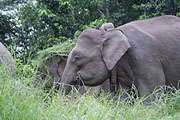Elephant data informs habitat protection

(PhysOrg.com) -- Collaborative Cardiff University research tracking the movements of three Bornean elephants will inform protection of their habitat.
The elephants were fitted with the satellite collars in a joint project carried out by the Danau Girang Field Centre (run jointly by Cardiff University and Sabah Wildlife Department) and French non-governmental organisation, Hutan.
PhD student Nurzhafarina Othman said: “We placed one satellite collar on a male bull, which we named Gading who has only one tusk, another on a female we identified via observation as being the head of the group or matriarch and we named her Benina.
“The final collar was fitted on a younger female, that had been collared previously by WWF-Malaysia, and named Bod Tai”
The data collected over nearly two years shows a pattern of movement which varies between the male and females. The data gathered will inform further research into the reasons behind this variation. This research will be published at the end of Nurzhafarina’s PhD, after enough long-term satellite data is collected to explain the movement patterns.
Dr Benoît Goossens, School of Biosciences and Director of the Danau Girang Field Centre, said the data obtained was vital in helping to understand how elephant movement varied within its population based on gender and age.
He said: “It is crucial to know if there is any traditional or common routes used by the elephants as it will help wildlife managers identify important areas within the sanctuary to establish wildlife corridors for the elephants.”
Danau Girang Field Centre is a collaborative research and training facility managed by Cardiff University and Sabah Wildlife Department.
It is situated in the Lower Kinabatangan Wildlife Sanctuary in Sabah, Malaysia and is surrounded by a mixture of lowland dipterocarp forest types, ranging from primary forest to disturbed secondary forest, in a matrix landscape with significant human impact including villages, small scale agriculture and oil palm plantations.
Provided by Cardiff University














